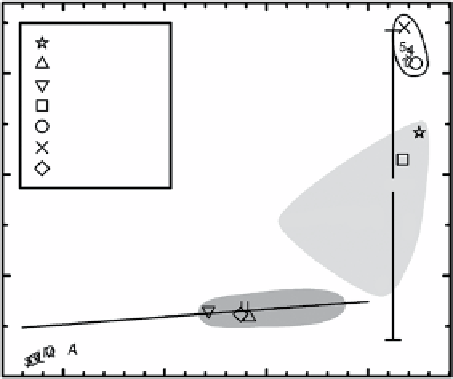Geology Reference
In-Depth Information
100
(a)
B
Y-793169
Y-793274
Y-981031
As-881757
NWA 032/479
NWA 4734
NWA 4884
YAMM
3
80
NNL
60
2
T
B
NNL
YAMM
40
T
B
e
E
1
Feldspathic
B
20
YQEN
Feldspathic
E
e
¥
YQEN
P
Y-793169
Y-793274
Y-981031
As-881757
NWA 032/479
NWA 4734
NWA 4884
0
0
(b)
5
10
15
FeO (%)
20
2.0
Figure 6.13.
Comparison of TiO
2
concentrations in ANSMET
(Table 6.1) basaltic meteorites (>12% FeO) to likely launch
pairs (meteorites in legend). The diagonal line is a least-squares
fit to the YQEN data showing that, with <1% TiO
2
, the basaltic
component is a VLT (very-low-Ti) basalt and that the feld-
spathic component is somewhat richer in Ti than most feld-
spathic lunar meteorites. For MIL 05035, three points are
plotted (B), representing the data (low to high TiO
2
) of
Joy et al
.
[2008],
Liu et al
. [2009], and this work. The error bar for our
data represents the 95% confidence interval based on analysis
of 11 subsamples. The meteorite is very coarse grained.
NNL
¥
1.5
YQEN
¢
U
1.0
E
e
T
0.5
q
B
P
L
YAMM
I
$
£
A
0.0
5
10
15
20
6.5.6. Meteorite Hills 01210
FeO (%)
MET 01210 is a glassy-matrix regolith breccia domi-
nated by low-Ti or VLT mare basalt.
Huber and Warren
[2005] note that “roughly half of the pyroxenes display
exsolution to extents that vastly exceed the norm (<<0.1
µm typical lamella width) for
Apollo
mare basalts” and
that “MET 01210 thus joins lunaites Y-793274, QU94281,
EET87521, and (to a lesser degree) As-881757, in having
undergone a remarkable extent of slow cooling or anneal-
ing, in comparison to
Apollo
mare basalts.” There is no
evidence that MET 01210 is related to the YQEN clan,
however. CRE data for MET 01210 are distinct from that
of QUE 94281 and EET 87/96 (Figure 6.11), and the
compositions are different (Figures 6.12 and 6.13). The
meteorite contains some feldspathic material in the form
of impact-melt and granulitic breccias, symplectites from
breakdown of pyroxferroite, and rare agglutinates and
spherules [
Arai et al
., 2005;
Huber and Warren
, 2005;
Zeigler et al
., 2005;
Day et al
., 2006b;
Joy et al
., 2006a;
2010a].
Arai et al
. [2005] note that a basalt clast in MET 01210
is very similar to that of gabbroic lunar meteorite Asuka
881757, collected in Antarctica 2850 km away, and that
the two meteorites might be “petrogenetically related.”
Figure 6.12.
(a) Sc/FeO is nearly constant among feldspathic and
very-low-Ti dominated, basaltic lunar meteorites (YQEN field).
The diagonal solid line is a least-squares fit to the “feldspathic” and
seven YQEN points. The dotted line is a least squares fit to the four
YAMM meteorite points. If MET 01210 (T) is a simple binary mix-
ture of mare basalt such as that of the high-FeO YAMM meteorites
and some low-FeO, nonmare component, then the low-FeO com-
ponent has a composition that is not highly feldspathic, having a
composition at the intersection of the diagonal lines at 11.5% FeO.
The inset shows data for 10 subsamples of MET 01210 [
Korotev
et al
., 2009b]. (b) The implied low-FeO component of MET 01210
(intersection of diagonal dotted line and dashed vertical lines) has
about 1.1 µg/g Th, greater than most feldspathic lunar meteorites.
The fact that the implied nonmare component plots near the field
of the YQEN meteorites is a coincidence in that two launch-pair
groups have different CRE exposure histories. The solid diagonal
line is a least-squares fit to the seven YQEN points. If these breccias
represent simple binary mixtures, then the feldspathic component is
also richer in Th (~1.1 µg/g) than most feldspathic lunar meteorites.
For the ANSMET meteorites, plot symbols are in Table 6.1. Data
for the meteorites in the legend are from
Barrat et al
. [2005],
Fagan
et al
. [2002],
Fukuoka
[1990],
Jolliff et al
. [1993],
Koeberl et al
.
[1991b, 1993],
Korotev et al
., [1993, 2009b],
Lindstrom et al
. [1991c],
Warren and Kallemeyn
[1991b, 1993],
Yanai and Kojima
[1991],
Zeigler et al
. [2005], and unpublished data (this lab).


